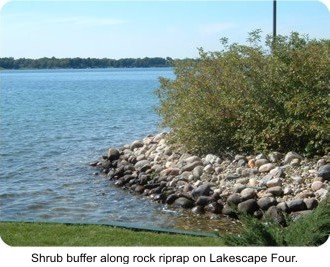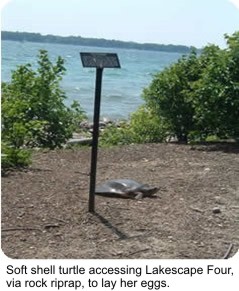Landscape Four
 The following are the major features of Kellogg Biological Station (KBS) Shoreline Management Demonstration Area Lakescape Four.
The following are the major features of Kellogg Biological Station (KBS) Shoreline Management Demonstration Area Lakescape Four.
Erosion Control
Heavy wave and ice action due to prevailing winds at this site called for a more hard-armored approach to soil erosion. For this reason rock riprap (Figure 5) extending from the lake bottom to the shoreline was established and lined with geotextile fabric. The fabric protects shoreline soils from wave energy that might otherwise pull individual soil particles out through spaces between the rocks.
Habitat Enhancement
The use of rock instead of vertical sea wall allows for the movement of turtles onto the shore to lay eggs. A buffer strip of native and non-native woody shrubs provides food, cover and nesting areas for a variety of shoreline animals. The interplanting of woody shrubs between the rocks would have provided more shade, cover and nesting areas at the water’s edge.
Reduced Lawn Maintenance
The buffer strip of woody shrubs incorporated into Lakescape Four reduces the amount of mowing and moves intensive lawn care activities away from the water’s edge. A buffer strip of taller, more long-rooted plants, shrubs or grasses is a simple way to reduce erosion and slow runoff.
Septic Systems
In shoreline areas with poorly maintained septic systems and high water tables, sewage effluent released to groundwater can carry phosphorus and nitrogen to the lake where it can contribute to nuisance aquatic plant growth. Lakescape Four demonstrates the use of woody shrubs which provide a zone of root structure that can help to intercept septic system nutrients before they reach the lake.

